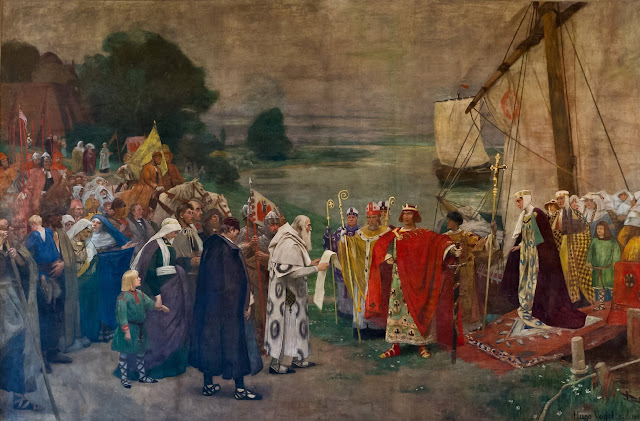In 924, Edith’s half-brother, Athelstan, succeeded to the English throne after Edward the Elder’s death. His mother was Edward’s first wife, Ecgwynn, one of the more obscure figures in English royal history. And after Athelstan took the crown of England, European affairs began to impinge on the young woman’s life.
This happened when Henry the Fowler, King of the East Franks, decided it would be a good idea to unite with the English crown. East Francia occupied territory which now lies in modern Germany. According to legend, the monarch was named “the Fowler” because he was engaged in snaring birds when he heard he was to be ruler.
Henry then proposed to Athelstan that his eldest son, Otto, marry one of the English King’s half-sisters. This was one way of strengthening ties between the two kingdoms. The King, in fact, chose two half-sisters for a potential royal wedding: Edith and her sibling Edgiva. The pair then travelled to East Francia to meet their potential husband. Once there, Henry’s heir simply picked the woman he found most pleasing as his future wife.
In those days, royal marriages tended to be matters of high politics rather than romance. Otto evidently preferred Edith, as it was she he chose to marry. And well he might have done. A 2010 article about her in The Guardian quoted the words of tenth century German nun and poet, Hrotsvitha of Gandersheim.
Describing Edith, Hrotsvitha wrote, “In fact, she was so very highly regarded in her own country that public opinion unanimously rated her the best woman who existed at that time in England.” A glowing tribute indeed… Even though no one was likely to utter an unkind word about a princess in tenth century Germany.
So Edith and Otto duly married in 930. In 936, a stroke killed Henry the Fowler, which may well have been welcome news for Germany’s bird population. For Otto, though, it meant that he now became the King of the Franks. And the tidings propelled Edith into the position of Otto’s queen at around 25 years old. The Wessex girl was now the Queen of Germany, or at any rate, East Francia.
Otto I went on to become known as Otto the Great. This accolade came about because of his success continuing Henry’s work in uniting the disparate tribes of Germany under his rule. He also took control of the Roman Catholic Church in Germany. And he would go on to become Holy Roman Emperor from 962.
But by the time Otto became Holy Roman Emperor, Edith had already been dead for some 16 years. Her unexpected death came when she was only in her middle thirties, in January 946. We don’t know a great deal about how the queen occupied her time on the German throne. It’s said, though, that she was active in charitable works involving gifts to various religious institutions.
During Edith’s reign, she also gave Otto two children, a son and a daughter. Liudolf was born in 930, the very year the royal couple married. He died of a fever aged only 27 while invading Italy. The daughter, born in 932, was Liutgarde. She married Conrad the Red and died in 953 when she was only 22. Early death, it seems, was an occupational hazard of being born in the Middle Ages.
Edith was originally interred in the Benedictine Monastery of St Maurice. This was an institution that she and Otto had founded in Magdeburg in 937. St Maurice is believed to have been an Egyptian Christian who served in the Roman Army in the third century, rising to the rank of commander of 1,000 legionaries. He later died as a martyr for refusing to attack fellow Christians.
But the St Maurice monastery was not to be Edith’s final resting place. Her remains were, in fact, moved three times or more over the years until their re-interrment in 1510 at Magdeburg Cathedral. And there they remained, as far as anyone knew, for the next 500 years. Then, in 2008, German archaeologists prepared to open her tomb.
To be continued :
The Roving Reporter












No comments:
Post a Comment
Through this ever open gate
None come too early
None too late
Thanks for dropping in ... the PICs